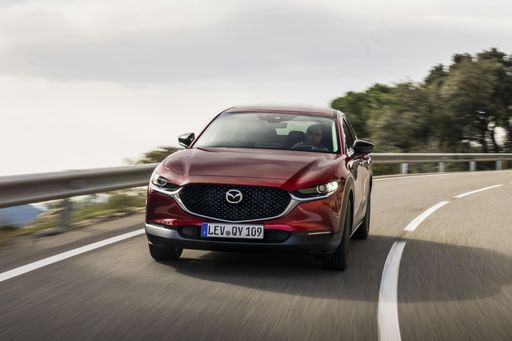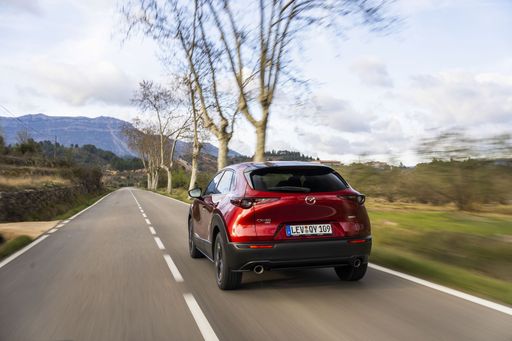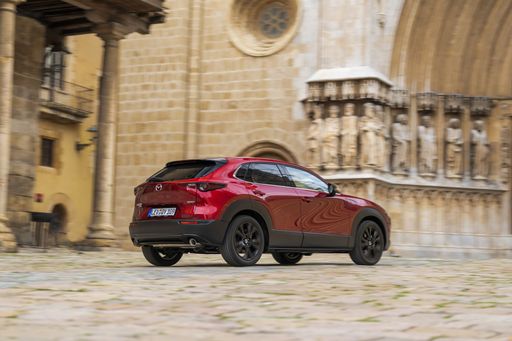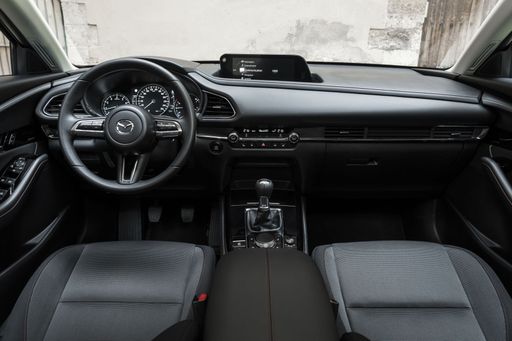Mazda MX-30 vs VW Transporter Bus – Differences & prices compared
Compare performance, boot space, consumption and price in one view.
Find out now: which car is the better choice for you – Mazda MX-30 or VW Transporter Bus?
The Mazda MX-30 (SUV) comes with a Plugin Hybrid engine and Automatic transmission. In comparison, the VW Transporter Bus (Bus) features a Diesel, Petrol, Plugin Hybrid or Electric engine with Manuel or Automatic transmission.
When it comes to boot capacity, the Mazda MX-30 offers 350 L, while the VW Transporter Bus provides 763 L – depending on how much space you need. If you’re looking for more power, decide whether the 170 HP of the Mazda MX-30 or the 286 HP of the VW Transporter Bus suits your needs better.
In terms of consumption, the values are 18.30 kWh per 100 km for the Mazda MX-30, and 22.40 kWh0.80 L for the VW Transporter Bus.
Price-wise, the Mazda MX-30 starts at 30800 £, while the VW Transporter Bus is available from 41500 £. Compare all the details and find out which model fits your lifestyle best!
Mazda MX-30
The Mazda MX-30 is a compact crossover that combines unique design with an environmentally conscious approach. Its distinct exterior features a coupe-like silhouette and freestyle doors that offer practicality and style. Inside, the cabin boasts sustainable materials, creating a harmonious blend of modern aesthetics and eco-friendly innovation.
details @ de.mazda-press.com
@ de.mazda-press.com
 @ de.mazda-press.com
@ de.mazda-press.com
 @ de.mazda-press.com
@ de.mazda-press.com
 @ de.mazda-press.com
@ de.mazda-press.com
VW Transporter Bus
The VW Transporter Bus from Volkswagen Commercial Vehicles is a versatile and reliable choice for both business and leisure purposes. It offers ample space and a flexible interior, making it ideal for transporting passengers or goods comfortably. The vehicle combines practicality with modern styling, ensuring it meets the demands of everyday use while maintaining an eye-catching appearance.
details

|
|
|
|
|
Costs and Consumption |
|
|---|---|
|
Price
30800 - 37100 £
|
Price
41500 - 85100 £
|
|
Consumption L/100km
-
|
Consumption L/100km
0.8 - 9.2 L
|
|
Consumption kWh/100km
18.30 kWh
|
Consumption kWh/100km
22.4 - 24.9 kWh
|
|
Electric Range
85 km
|
Electric Range
87 - 324 km
|
|
Battery Capacity
-
|
Battery Capacity
11.8 - 63.8 kWh
|
|
co2
22 g/km
|
co2
0 - 229 g/km
|
|
Fuel tank capacity
-
|
Fuel tank capacity
45 - 60 L
|
Dimensions and Body |
|
|---|---|
|
Body Type
SUV
|
Body Type
Bus
|
|
Seats
5
|
Seats
4 - 8
|
|
Doors
5
|
Doors
4 - 5
|
|
Curb weight
1849 kg
|
Curb weight
1998 - 2620 kg
|
|
Trunk capacity
332 - 350 L
|
Trunk capacity
0 - 763 L
|
|
Length
4395 mm
|
Length
4973 - 5450 mm
|
|
Width
1848 mm
|
Width
1941 - 2032 mm
|
|
Height
1555 mm
|
Height
1907 - 1997 mm
|
|
Payload
402 kg
|
Payload
330 - 1143 kg
|
Engine and Performance |
|
|---|---|
|
Engine Type
Plugin Hybrid
|
Engine Type
Diesel, Petrol, Plugin Hybrid, Electric
|
|
Transmission
Automatic
|
Transmission
Manuel, Automatic
|
|
Transmission Detail
Reduction Gearbox
|
Transmission Detail
Manual Gearbox, Automatic Gearbox, Dual-Clutch Automatic
|
|
Drive Type
Front-Wheel Drive
|
Drive Type
Front-Wheel Drive, All-Wheel Drive, Rear-Wheel Drive
|
|
Power HP
170 HP
|
Power HP
110 - 286 HP
|
|
Acceleration 0-100km/h
9.10 s
|
Acceleration 0-100km/h
7.4 - 16.9 s
|
|
Max Speed
140 km/h
|
Max Speed
112 - 200 km/h
|
|
Torque
-
|
Torque
310 - 415 Nm
|
|
Number of Cylinders
-
|
Number of Cylinders
4
|
|
Power kW
125 kW
|
Power kW
81 - 210 kW
|
|
Engine capacity
830 cm3
|
Engine capacity
1498 - 2488 cm3
|
General |
|
|---|---|
|
Model Year
2025
|
Model Year
2024 - 2025
|
|
CO2 Efficiency Class
B
|
CO2 Efficiency Class
G, F, B, A
|
|
Brand
Mazda
|
Brand
VW
|
Mazda MX-30
The Electric Revolution: Mazda MX-30
The Mazda MX-30 represents a bold leap into the realm of sustainable mobility, bringing a distinct blend of style, efficiency, and innovation. As Mazda's first all-electric vehicle, the MX-30 is designed to capture the hearts of eco-conscious drivers while delivering the fun driving experience the brand is known for. Let’s delve into what makes this vehicle stand out in the increasingly crowded electric vehicle market.
Sleek Design Meets Practicality
The MX-30 is a compact SUV that exudes a modern aesthetic with its clean lines and contemporary silhouette. Measuring 4,395 mm in length and 1,848 mm in width, the MX-30 is designed to navigate city streets with ease. Its unique freestyle doors facilitate easy access to the front and rear seats, accommodating up to five passengers comfortably.
Advanced Electric Powertrain
At the heart of the MX-30 is Mazda's e-SKYACTIV drivetrain, available in both fully electric and plug-in hybrid variants. The electric version delivers a respectable 145 PS (107 kW), whereas the plug-in hybrid offers an enhanced 170 PS (125 kW). Both versions employ front-wheel drive with a single-speed reduction gearbox, ensuring a smooth and responsive ride.
Efficiency and Range
The MX-30 showcases commendable efficiency with a power consumption ranging from 17.5 to 17.9 kWh per 100 km. Drivers can expect a maximum electric range of 200 km for the fully electric model, while the plug-in hybrid offers 85 km on electric power alone. This ensures the MX-30 is well-suited for both daily commutes and extended journeys.
Elegant Interiors and Cutting-Edge Technology
Inside, the MX-30 presents a zen-like cabin featuring sustainable materials like cork and recycled fabrics, reinforcing Mazda’s commitment to environmental consciousness. The vehicle comes equipped with a host of technological advancements, including a digital dashboard and a user-friendly infotainment system that keeps drivers connected and informed on the go.
Performance and Handling
Mazda's dedication to driving pleasure continues with the MX-30. With an acceleration time from 0-100 km/h between 9.1 to 9.7 seconds and a top speed of 140 km/h, it promises an engaging drive. The low centre of gravity, courtesy of the battery placement, and its precise steering ensure the MX-30 feels agile and responsive, whether navigating urban environments or open roads.
Safety and Features
Safety is paramount in the MX-30, which boasts an array of advanced features, including collision avoidance systems and a reinforced body structure. It also scores well on CO2-efficiency, rated between Class A and B, making it a responsible choice for eco-minded consumers.
Conclusion: Mazda MX-30 – A Vision of the Future
In conclusion, the Mazda MX-30 is a testament to the brand's innovative spirit and commitment to sustainability. With its combination of striking design, efficient powertrains, and cutting-edge technology, the MX-30 is a formidable competitor in the electric vehicle market. Offering a blend of sophistication and performance, it is poised to win over motorists who seek an environmentally friendly vehicle without compromising on driving joy.
VW Transporter Bus
The New Era of Transport: VW Transporter Bus T7
The VW Transporter Bus T7 has carved a niche in the automotive world as an exemplar of versatility and innovation. Easily sociable with its iconic predecessors, the Transporter Bus T7 reinvigorates the brand’s lineup with improved efficiency, top-notch technologies, and a design that balances practicality with modern aesthetics. Whether it's a family outing or a business venture requiring ample space and comfort, the T7 is engineered to deliver on all fronts.
Technical Marvels Under the Hood
The heart of the VW Transporter Bus T7 is a range of engines tailored to satisfy a variety of driving preferences. Leading the charge is the 2.0 TDI Diesel engine, meticulously crafted in both 110 HP and 150 HP outputs. This engine promises not only commendable power but also impressive fuel efficiency, with consumption figures ranging from 6.3 to 8.7 liters per 100 kilometers, depending on the version. For those enthralled by gasoline engines, the 2.0 TSI OPF Petrol variants deliver robust power at 204 HP, complemented by a smooth automatic gearbox.
Driving Dynamics and Performance
Performance meets reliability with the VW Transporter Bus T7's transmission options. The manual gearbox stands ready for those who prefer a connected, tactile driving experience, while the advanced automatic and double-clutch gearboxes ensure seamless gear shifts for a relaxed drive. Front-wheel drive configurations are standard, yet the all-wheel-drive variants offer enhanced stability and traction in diverse driving conditions.
Spacious Comfort and Ergonomics
Space management is quintessential in the Transporter Bus T7, providing various seating configurations ranging from five to eight seats. Designed with user-centricity in mind, the interior blends functionality with comfort — a testament to Volkswagen's commitment to ergonomic design. An extensive list of trims, including the Life, Style, and Ocean DSG variants, allows potential owners to tailor their Transporter Bus to their specific needs and preferences.
Modern Innovations and Connectivity
The T7 isn't just about transportation; it's about creating an experience. The latest model embodies state-of-the-art technology with intuitive infotainment systems and connectivity solutions. An array of safety features ensures peace of mind on the road, boasting adaptive cruise control, lane-keeping assist, and sophisticated sensor technologies which make every journey as safe as it is enjoyable.
Fuel Efficiency and Environmental Consideration
Volkswagen has taken strides in reducing the environmental footprint of the Transporter Bus T7. With CO2 emissions efficiency marked between classes F and G, the T7 nonetheless demonstrates a commitment to sustainability. Its intelligent design and advanced engineering reduce fuel consumption without compromising performance, ensuring a greener ride while keeping operation costs manageable.
A Timeless Design for Modern Times
Volkswagen's design philosophy stands clear in the Transporter Bus T7. The exterior impresses with its dynamic lines and contemporary aesthetics — every inch is crafted to convey strength and purpose. The dimensions, with lengths measuring between 4973 mm and 5450 mm, coupled with widths around 1941 mm and a height reaching up to 1972 mm, make the T7 both an admirable presence and a practical choice for urban and rural settings alike.
In conclusion, the VW Transporter Bus T7 represents a harmonious blend of performance, innovation, and versatility. It's a vehicle engineered for those who require functionality wrapped in modern mechanics and technology, setting a new standard in the art of transporting both people and ideas into the future.
Which drive types are available for the Mazda MX-30?
Available as Front-Wheel Drive.
The prices and data displayed are estimates based on German list prices and may vary by country. This information is not legally binding.
